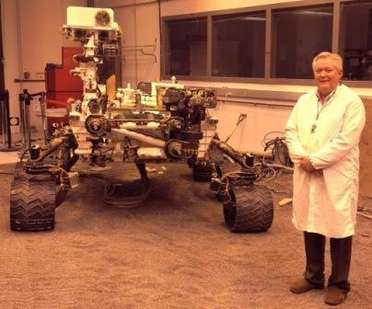Curiosity uses X-rays to examine samples on the Red Planet – a first for a Mars mission

(Phys.org) —During the nearly 14 months that it has spent on the red planet, Curiosity, the Mars Science Laboratory (MSL) rover, has revealed a great deal about Mars' composition and history. Analysis of observations and measurements by the rover's science instruments during the first four months after the August 2012 landing are detailed in a series of five papers in last week's edition of the journal Science.
ASU professor Jack Farmer, a scientist on the rover's CheMin instrument team, is an author on two of the papers; one of which focuses on the composition and formation process of the Rocknest sand shadow, a small ripple of loose, wind-transported sand and dust. The other provides an evaluation of fine- and coarse-grained soil samples.
"The past few months the MSL team has been working our way from Yellowknife Bay toward the base of Mount Sharp, which is a primary goal for the mission. We have just completed our work at our first waypoint along the way to our destination," says Farmer.
The first stop was Rocknest for an initial test of the functionality of Curiosity's onboard analytical laboratory instruments, including the miniaturized laboratory for identifying minerals CheMin, short for "Chemistry and Mineralogy." This shoebox-size laboratory uses X-rays to determine what minerals are present in a material, as well as provide information about elemental abundances – a first for a mission to Mars.
"Curiosity has completed the first comprehensive mineralogical analysis on another planet using X-ray diffraction, the gold standard laboratory method for mineral identification on Earth," says Farmer. "It is a more quantitative method for identifying minerals than has been possible with previous Mars missions."
Another instrument tested at Rocknest was Curiosity's Sample Analysis on Mars (SAM), a tiny oven that heats samples and identifies the composition of gases given off by them. Professor Meenakshi Wadhwa is a collaborator with SAM.
At Rocknest, Curiosity's robotic arm collected several scoops of loose sand and dust and delivered them into the portable laboratories for analysis.
"This little wind ripple provided well-sorted materials in the right size range for sieving and delivering to the CheMin and SAM instruments. This was important, because at this early stage of the mission we were still doing our stepwise testing of the payload instruments and were not yet ready to deploy the drill to sample rocks. We used materials already ground up and sorted by the wind as our test materials and in the process learned a lot about surface materials at Gale," explains Farmer.
CheMin will analyze as many as 74 samples during the nominal prime mission, providing information about the environment at the time and place where the minerals in the rocks and soils formed or were altered.
Results are in
CheMin's analysis reveals that the Rocknest drift has a complex history. The findings provide new understanding of the local and global processes on Mars and clues to the planet's volcanic history.
The results indicate that the ripple materials had a basaltic composition, similar to soils that have been analyzed elsewhere on Mars. This confirmed the presence of basaltic source rocks in Gale Crater, and the absence of weathering products, like clays, suggests minimal interactions with water since the materials were liberated from their source rocks. Basalt is the volcanic rock that makes up most of the Earth's crust, particularly the ocean floors. This Martian soil appears very similar to some weathered basaltic soils seen on Earth, in places like Mauna Kea, Hawaii.
X-ray analysis identified 10 distinct minerals, although half of these were in low abundance, near the detection limits of CheMin. Curiosity also discovered that an unexpectedly large portion of the Rocknest composition is a type of disordered material, similar in structure to glass.
"Perhaps the most interesting thing about the materials at Rocknest concerns the abundance of amorphous – essentially glassy – materials. These amorphous materials which make up nearly 45% of the sand ripple are essentially invisible to X-ray Diffraction. Their presence is inferred by combining CheMin results with elemental data from the Alpha Proton X-ray Spectrometer," explains Farmer.
This is the first time the amorphous component of soils has been quantified for Martian surface materials and that is important for understanding what Mars is made of and how the materials have been affected by recent surface weathering processes. The results of the SAM instrument further suggest that water and other volatiles detected in the ripple deposit are likely to reside in the amorphous component of the soil.
Team spirit
What is it like being part of a team that is responsible for our evolving view of our neighbor Mars?
"It's invigorating, but also challenging," says Farmer, who juggles his MSL duties with teaching, advising graduate students and NASA Space Grant interns, and conducting his own research and proposal writing activities.
Since leaving Yellowknife Bay, the CheMin team has been digesting and refining its interpretations of the data obtained at Yellowknife Bay in order to better understand the nature of the aqueous environments they believe existed there long ago. The process of refinement requires careful, painstaking work achieved through lots of interaction among team members.
"Most every day, I dial in to MSL science meetings to review and discuss new data. Mondays, Wednesdays and Fridays this semester, I am available to fulfill my main MSL operational role as a CheMin downlink lead. Next week I will attend an MSL team meeting at JPL and will deliver my class lectures and discussions via Blackboard and Skype," says Farmer.
For Farmer, sharing what he learns from Curiosity with his students is a priority. He regularly provides his students with mission updates and utilizes the full-scale model of Curiosity in ASU's Interdisciplinary Science and Technology Building IV.
Journal information: Science
Provided by Arizona State University





















